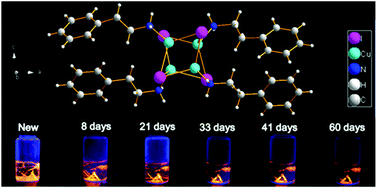Lead-free, stable orange-red-emitting hybrid copper based organic–inorganic compounds†
Abstract
Metal halide perovskites have been extensively studied recently by virtue of their extraordinary luminescence characteristics. However, they still suffer from severe stability issues, and contain a toxic metal lead. Here, single crystals of (PEA)4Cu4I4, a lead-free orange-red-emitting organic–inorganic copper-halide compound with a photoluminescence quantum yield (PLQY) of 68%, were synthesized via a simple solvent vapor diffusion process with commercially-available phenylethylamine (PEA) as a ligand. The crystals show superior stability to perovskites with retaining 60% of their initial photoluminescence (PL) intensity after 60 days in water, which is due to the hydrophobic nature of PEA and the stable Cu–N bonds. Phase transition is found to take place upon lowering the temperature, which causes a redshift of the PL peak. The emission band is identified to be associated with triplet cluster-centered (CC) excited states because of their shortened Cu–Cu distances, excitation-independent PL and long PL lifetime. In addition, micron-sized oleic acid capped (PEA)4Cu4I4 particles were developed by a hot-injection method, and they possess similar stability to that of bulk crystals. A monochrome LED was further fabricated by employing the as-prepared micron-sized particles as phosphors, demonstrating their potential for optoelectronic applications.



 Please wait while we load your content...
Please wait while we load your content...